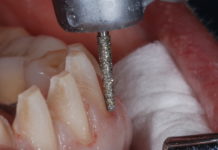
A Comprehensive Guide to Treating Comprehensively.
For almost eleven years, I had the privilege of traveling around the country with Dr. Dick Barnes. We went on the road to fulfill the main goal of Arrowhead Dental Laboratory—to share tried-and-true strategies so that our clients could become better and more productive dentists. We visited every state in the Union except Alaska and Hawaii. We didn’t just visit each place once—sometimes we went to locations multiple times.
During our travels, we went from dental office to dental office, sharing dental practice management tips and teaching dentists how to help their patients discover what is needed to maintain healthy teeth, or to restore teeth to good health.
Whenever we visited an office, the first question that Dr. Barnes always asked was, “How’s your practice going?” From that simple but comprehensive question, we learned many things. A dental practice is not just the procedures you do and the services you offer. A dental practice includes the relationships with patients, the organizational behavior of team members, the business practices, the interactions within the dental industry, the overall reputation of the dentist (including the digital and local community presence), and other outside forces. In other words, a dental practice is made up of many factors that combine to produce great dentistry.

In the past, dentists graduated from dental school, set up shop, and expected to almost effortlessly have patients. But it’s a totally different environment today. Dr. Barnes says, “Now, dentists have to co discover with patients what is needed, so that they can produce great, life-changing dentistry.”
From traveling with Dr. Barnes, I learned three keys to a successful practice. First, dentists should learn to develop business relationships from the outset. Second, dentists should think and present comprehensively. It is important for dentists to know and believe in the value of their dentistry, mentor their teams about the value of dentistry, and teach all patients about the value of dentistry. Third, schedule for production and set clear, daily goals.

DEVELOP RELATIONSHIPS
Dr. Barnes always emphasized the importance of a new patient’s first visit. Whenever an office welcomes a new patient, it is the single most important visit! It’s important for the front desk team members, for the team members in the back of the office, for the dental assistants, the dental hygienists, and for the dentist.
The new patient visit should be conducted in such a way that the patient feels like there’s nobody else in the world but him or her. Dr. Barnes suggests imagining every new patient coming into the office carrying a big sign that says, “Make me feel important!” If dentists visualize that scenario, they will remember to make new patients a priority.
During the dentist’s initial meeting with a new patient, his or her job involves more than simply discussing why the patient is coming in. The job is also to establish a comfortable doctorpatient relationship. How can a dentist do this successfully?
It’s the simple but important things that matter: ask the patient about his or her family; ask about where they are from; ask about how they were referred to the office; and ask about why he or she chose to visit your practice.
It’s amazing how patients feel when you develop a relationship and talk about personal things. When doctors take the time to treat patients as individuals, patients develop a high trust/low fear relationship with the dentist. Such relationships are ideal and are key to having patients understand and accept the value of treatment. For some dentists, the activity of developing relationships can be uncomfortable. But from a business perspective, it is critical for business development.
During the initial meeting, details matter. If doctors are wearing scrubs and a surgical mask with loupes hanging down, patients will sense that he or she is in a hurry and doesn’t have time for them. Instead, get comfortable, relax, lose the mask and the loupes, and as Dr. Barnes says, “sit eye–to-eye and knee to knee with your patients.”
It doesn’t have to be a long conversation—you’ll be surprised that three minutes can go a long way. If you spend a little extra time with the patient, he or she will feel like you talked for hours. Dr. Barnes always says, “Talk about them and tell them about yourself. Discuss pleasantries.” Remember that dentists sit in front of a whole person, not just a mouth full of teeth.
Ask questions, because everybody likes to talk about themselves. If you keep the conversation lively and light, people will remember you and like you—and more importantly, they will trust you. People like to do business with people they trust.
Dr. Barnes suggests relating to something that the patient tells you. Take notes after the conversation if it’s helpful. That way, when the patient returns, you can ask, “How is your husband doing with the trees he was planting?” Or, “I remember that you were going on a great vacation to Florida. How did that go?”
Always keep a positive outlook during the conversation. A positive mental attitude is a very powerful tool when you meet someone new. People can tell immediately whether you have a positive mental attitude or a negative one. The dentist sets the tone for the office with his or her mental attitude and approach towards patients.
TREATMENT ACCEPTANCE
Once you get past the pleasantries, you can learn more about each patient’s particular personality and understand the best way to communicate with him or her. When it comes to case presentation, the way you approach each patient may be a little bit different.
In the Fall 2015 issue of Aesthetic Dentistry, Dr. Jim Downs wrote an article called, “I Object! Getting Patients to Say YES to Treatment.” He said, “Some of your patients are going to want a= lot of information to buy into the dentistry. Others will be overwhelmed by a lot of information.” The only way you can know whether people want a lot of information or the bare minimum is to get to know them.
Dr. Barnes recognizes that this approach requires some time and effort. And for introverts, it’s not something that necessarily comes easy. Dr. Barnes had to work at it, too. He was an introvert and it wasn’t natural for him to be outgoing and inquisitive with others—he had to develop those skills.
Therefore, read and study about ways to become more outgoing. There are several ways to do it. As you read about different techniques and practice them, you’ll find a way that suits your personality and you’ll improve your skills.
Most people don’t want to go to the dentist, so try to make it as pleasant and as remarkable an experience as possible. Patients should feel that when they visit the practice, they are going to see someone they know and like—someone they trust and whose opinion they value. After developing a good relationship, patients will trust that their doctor is going to help them maintain their good teeth or restore them to good health.
Every doctor struggles with getting patients to accept treatment. But a good relationship with your patients helps improve case acceptance. A good relationship doesn’t guarantee a “yes” every time, but when patients are comfortable and keep coming back to see you, it’s more likely they will trust you and proceed with treatment.
Dr. Barnes said, “One of the constants in a dental practice is that many patients will tell you ‘no’ to treatment. You’ll have to deal with that throughout your career. But a ‘no’ today doesn’t mean a ‘no’ tomorrow.”
Think of case presentation in terms of an investment—you cannot have expectations of a dividend yield from an investment that you never made. That investment is an honest and ongoing conversation with your patients. If you have that discussion, it establishes a foundation for case acceptance later on.
Some cases take time, but you’d be surprised at how many patients show up years after the original case presentation and say, “I’m ready to do what you told me to do.” They may not remember in detail what you suggested, but they will remember that the work is important. But if you don’t have that initial conversation, the investment will never yield a valuable result.
Occasionally, take time to evaluate and revisit the status of each patient relationship. If you have not seen a patient for a while, treat him or her like a new patient. Sometimes you can get to know that patient all over again.
THINK COMPREHENSIVELY
The second way to improve your practice is to take a comprehensive approach to your patients’ health. A dentist’s job is to share what is needed for patients to maintain or restore their teeth to good health. Whether a patient says “yes” or “no,” or whether you perceive that a patient can or cannot afford the dentistry is immaterial. Every patient should be presented with comprehensive dentistry.
Some patients will say, “Please don’t find anything,” but they need to know what is going on with their teeth. Teaching patients about their teeth helps create value for the work.
Today, the life expectancy for men and women has been extended. Remind patients that teeth were originally expected to last for perhaps 50 years or so, and now people are living well beyond that, so it’s important to protect their teeth. If you teach patients the value of keeping their teeth (value equals benefits minus cost), they will get the work done.
A SIMPLE EVALUATION
At every visit, Dr. Barnes was a true mentor to his peers on how to refine and rejuvenate their practice—which always began by thinking comprehensively. Dr. Barnes would often ask doctors to pretend that they had just bought their practice, and then ask them three questions to consider as the new owner.
The first question was, “How many adult prophys are in the practice?” This question is important because in general, half of all adult patients will need one crown. Some adult patients will need no work, others will need much more work, but that is an average amount.
The second question was, “How many new patients does the office have each month?” If dentists present comprehensively, the value of a new patient is between $3,000 and $5,000. Twenty-five new patients a month is a good goal for comprehensive dentists (or 30 patients a month for a drill-and-fill operation).
The third question was, “After presenting treatment, if patients tell you that they want to think it over, how do you respond?” How dentists respond to this question suggests whether or not they are closing on treatment.
Again, evaluate your practice as if you just bought it. Think about what you can do to improve the business. Ask yourself, “What specific areas could use improvement?” On his visits, Dr. Barnes offered a fresh, comprehensive, dentist-to-dentist perspective, and it helped doctors realize that there was always a lot more that they could share and communicate with their patients.
During our travels, dentists often asked Dr. Barnes how to transition from drill-and-fill dentistry to more comprehensive work. Inevitably, his answer involved taking time to visit with patients and explaining the value of the treatments they need. Even if patients don’t choose to have treatment done immediately, the dentist has set the stage for future (and likely more fruitful) conversations.
Once a good relationship is established, dentists can have a more direct conversation with patients. A dentist might say, ”Mrs. Jones, I’ve been seeing you for the past five years and I’ve noticed a lot of wear and tear. I believe it’s time for us to do something because my goal is to preserve your teeth for a lifetime. I would like to have you back for a diagnosis appointment and I will share with you exactly what I am going to do and how much it will cost before we do anything. I think you are going to be very happy with the results.” There are many ways to start such a conversation.
DON’T FEEL GUILTY ABOUT FEES
Finally, dentists should stop feeling guilty about the amount of their fees. If dentists know the value of dentistry, they shouldn’t worry about charging $20,000, $40,000, or even $75,000. Yes, it is a lot of money, but if dentists know the impact it will have on their patients’ lives, they can communicate that and patients will get the work done.
Many doctors offer discounts because they feel like they are charging too much. Dr. Barnes has said, “Don’t feel that way. I don’t give discounts because I know the value of my dentistry. I know exactly how much I charge and why I charge it.”
Every dentist should know the value of their dentistry—both from a clinical perspective and from a financial one. Believe in your dentistry, think comprehensively, and mentor your team to understand and convey the value of the treatment to all of your patients.
All successful practices have successful teams. The dentistry that you provide for your patients is absolutely remarkable, and it will change their lives. Your team should understand and believe in the value of your dentistry, too. It’s important for all team members to communicate the same message.
SCHEDULE FOR PRODUCTION
On our trips, the final message that Dr. Barnes would share with his clients was about goal setting. In order to maximize production, dentists must set goals. Dr. Barnes recommended that all dentists start with a yearly goal and work backwards to set daily goals, so they know exactly how much to produce every day.
Here’s how to do it: go to the yearly calendar and calculate how many days you are not going to work—take out weekends, vacations, holidays, etc. After you subtract those days from the calendar, the remaining days are how many days you will work.
For the sake of simplicity, let’s say that number is equivalent to two hundred days. Next, set a goal for how much revenue your office will generate. Let’s assume that your practice will produce a million dollars. If you divide your yearly production goal by the number of working days, you will get a daily production goal. If you are going to work two hundred days and produce a million dollars, your daily goal will be $5,000.
Without a daily goal, the team members will get lost. Dr. Barnes and I once visited an office that set a monthly goal, but had no daily goals. Guess what happened? The first two weeks of the month, everything was relaxed and stress-free. But during the last two weeks of the month, the practice was in chaos as they tried to reach their goal. When your team members feel stress, your patients feel stress. It’s important to have daily goals instead of monthly ones because they are much easier to digest.
Once you have your goals in place, schedule your day to be as productive as possible. Schedule all the production in the morning, and schedule the rest—crown seats and all the things that are non-productive in the afternoon. Scheduling this way provides structure to the day.
When patients call, your team members can tell them that you schedule certain appointments in the morning, and other less-urgent procedures in the afternoon. Scheduling for production is a way of training your patients. Your patients are scheduled when it’s convenient for you, and not the other way around.
COMING HOME
Being on the road with Dr. Barnes was always an adventure! Dr. Barnes always said, “If dentists invest in continuing education to get better, if they read about sales, and how to become a provider and an advisor to their patients, then they can convey the value of what they’re going to do.”

Blake McKinley, Practice Coordinator for Ray McKinley, D.D.S. & Brittany McKinley-Holloway, D.D.S. in Shelby Township, MI, has implemented Dr. Barnes’s advice for years. McKinley said, “The practice that is able to successfully implement all of these strategies will see an explosion of productivity, daily satisfaction with their work, and a patient base composed of elated fans.”
From Dr. Barnes, I learned the importance of dental practices becoming better and more productive. Together, we saw countless dental practices transform before our eyes. The feeling of helping practices improve is a contagious one. Even though Dr. Barnes is enjoying staying grounded these days, like the old Willie Nelson song says, “I can’t wait to get on the road again!”









